Sign up for The Media Today, CJR’s daily newsletter.
January 21, 2025. I shiver outside the DC Jail, where a restless crowd—family members, advocates, and camera crews—waits. Inside, pardoned January 6 inmates prepare to emerge, their records wiped clean with one spiky signature. “Let my people go!” a man bellows, hoisting an American flag as phone screens cast a blue-white glare, streaming every second for the faithful. From a tinny JBL speaker comes the crackle of “J6 Prison Blues”—I hear the feds a-coming, they’re false-flagging again… Nearby, framed by car headlights, Oath Keepers founder and convicted January 6 conspirator Stewart Rhodes draws on a cigar. Free despite an eighteen-year sentence, he exhales, his expression unchanged—like a man who always knew this day would come.
Their release isn’t just legal absolution—it’s vindication for a movement I’ve documented for a decade. I’ve photographed the MAGA machine—its bombastic rallies, street-brawl theatrics, and conspiracies forged into doctrine—across twenty-seven states, always on my own dime. For years, press access was routine. That changed in March 2023, at the first official rally of Trump’s second presidential campaign, in Waco, Texas. Thirty years after the FBI siege of the Branch Davidian complex—remembered by extremists as proof of federal overreach—Trump took the stage to a distorted anthem called “Justice for All,” sung by jailed January 6 rioters. “I am your warrior, I am your justice,” he declared.
That day, my credentials meant nothing—denied at the last minute, useless at the gates. Since then, the only way in has been to let the current take you—shoulder to shoulder with the masses. No press pen. Strip down the gear. Full immersion. Hours pass as the devoted inch forward, draped in bootleg MAGA merch, swapping theories about rigged elections, Elon Musk’s genius, and Hunter Biden’s laptop. Infiltration is the only option. Don’t look like “the enemy of the people.” From the inside, it’s clear—for many, this isn’t about policy. It’s prophecy.
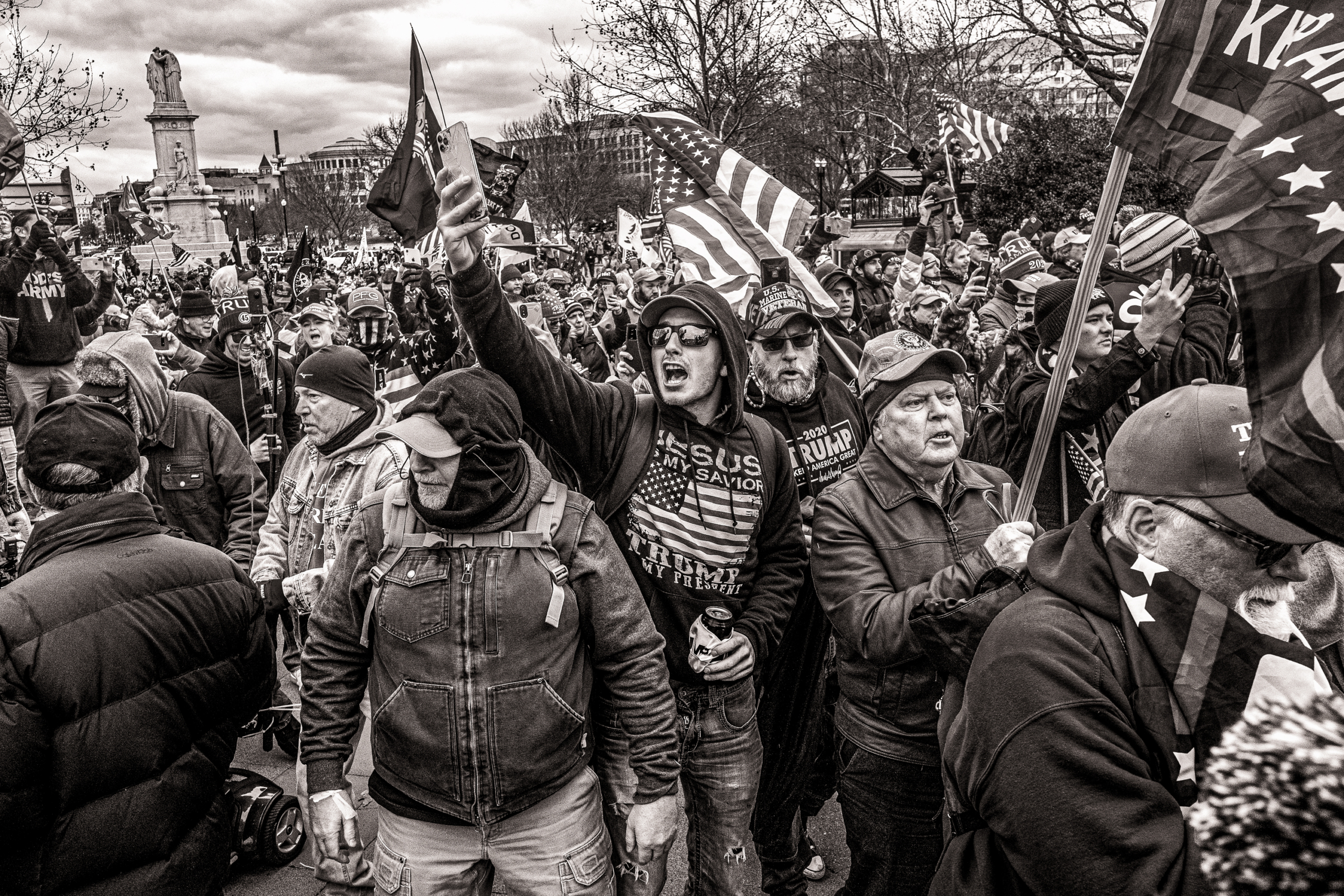
January 6, 2021. 10:43am. A formation of Proud Boys marches toward the Capitol, chanting “Fuck Antifa!” Minutes later, a masked militant lunges at me, snarling “Fake news!”
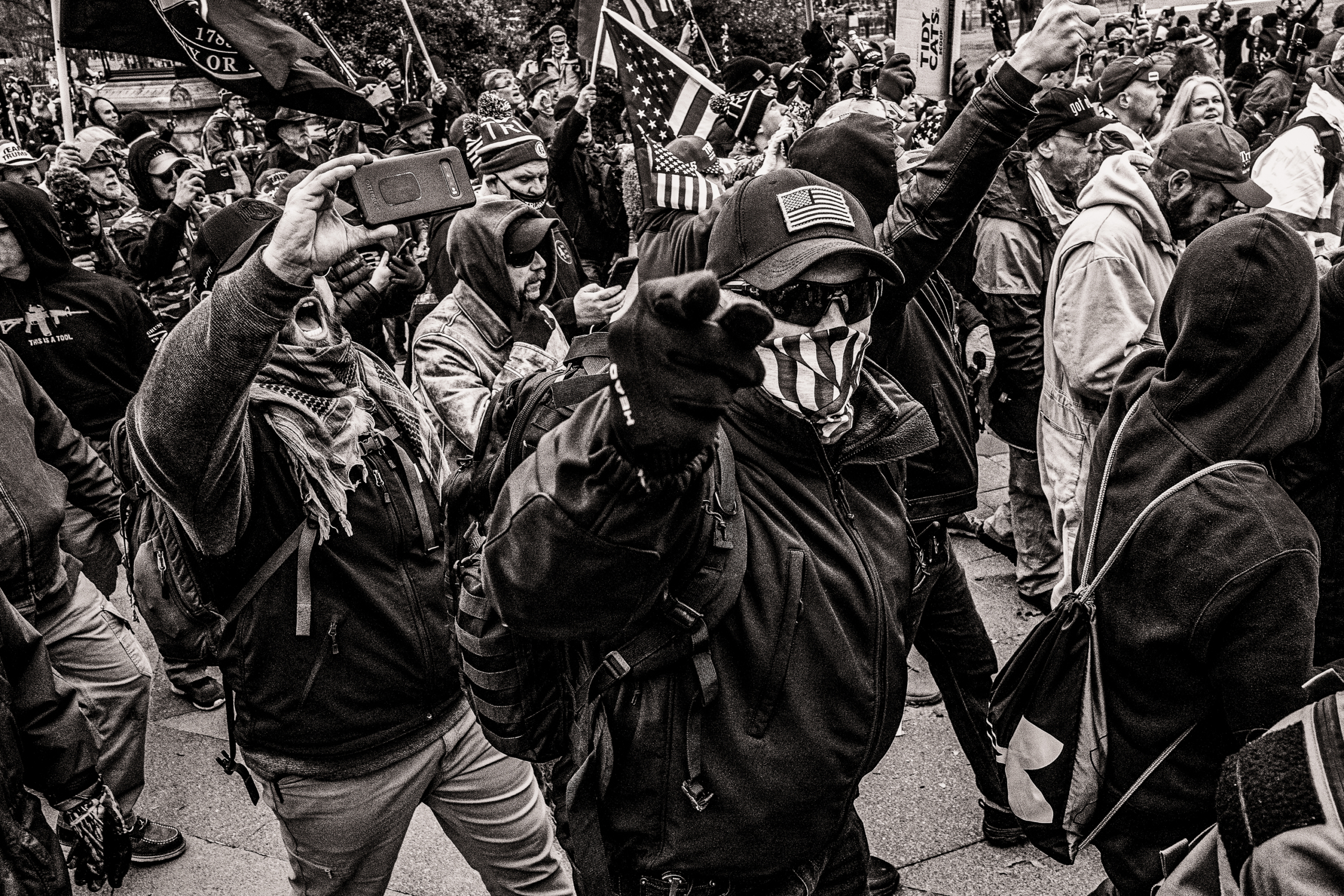
12:57pm. Thousands surge over toppled steel barricades, rushing the still-unfinished Inauguration Day stage. Another masked man yells “Fuck you!” and slams me off a three-foot balustrade—I land on my side, the impact rattling through my ribs. No time to dwell. I start taking photos on the sly—camera raised at odd angles, eyes averted, trying not to be noticed.
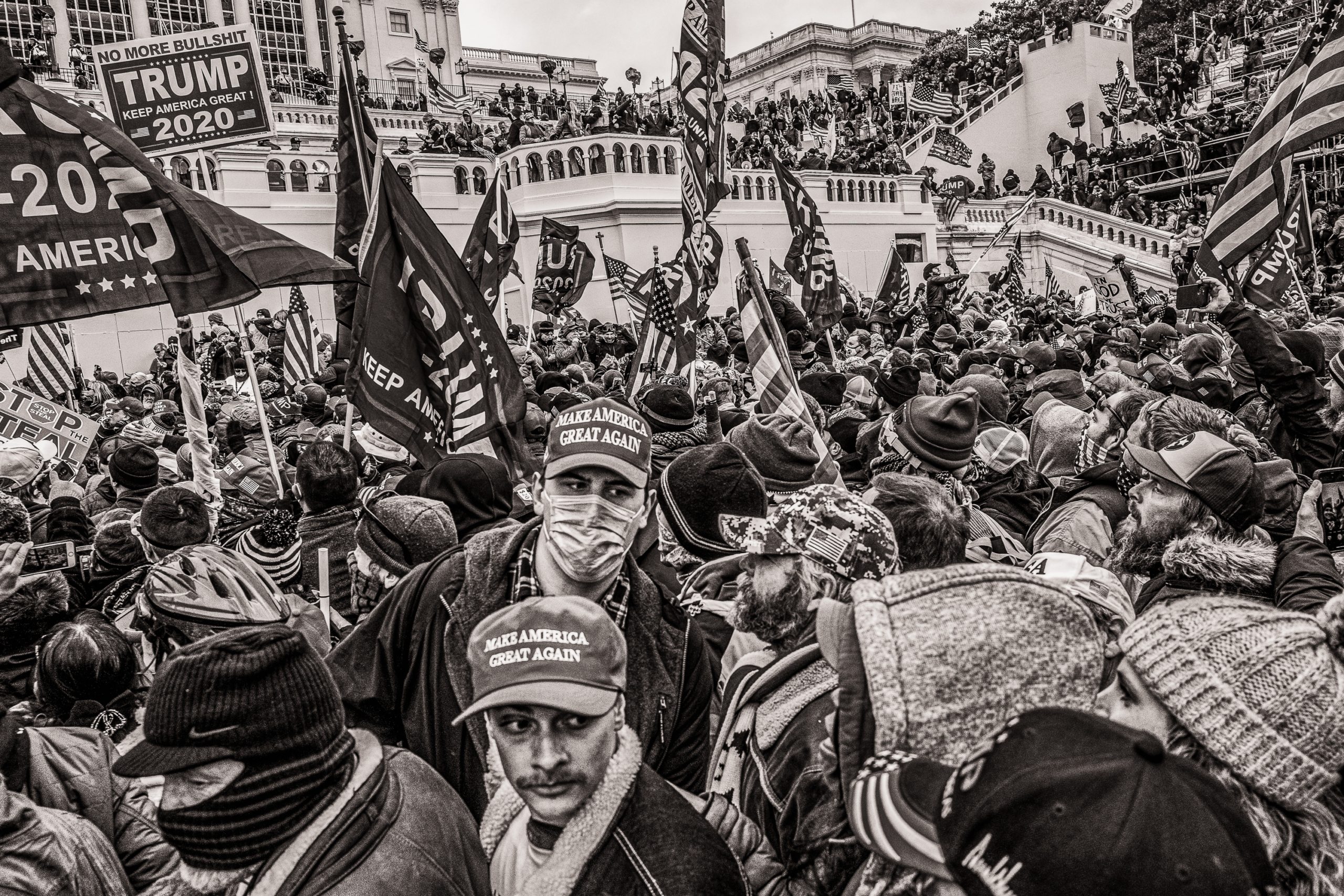
1:37pm. A fellow photojournalist is thrown from a five-foot retaining wall. I fear I’ll be next.
As a routine election certification devolves into chaos, I push through red hats bobbing like buoys in a storm. Some—later charged with obstructing Congress—move trancelike, swept up in the fiction of a stolen election. Others—who would go on to be charged with assaulting police—wear tactical vests, flagpoles clutched like spears, chanting “1776!” Above the fray, upside-down American flags, Confederate banners, “Don’t Tread on Me” insignias—even “Back the Blue” flags—snap in the wind, as their bearers overwhelm law enforcement. “Hold the line!” and “Hang Mike Pence!” echo through tear gas and sweat-soaked air, thick with the breath of an ignored pandemic.
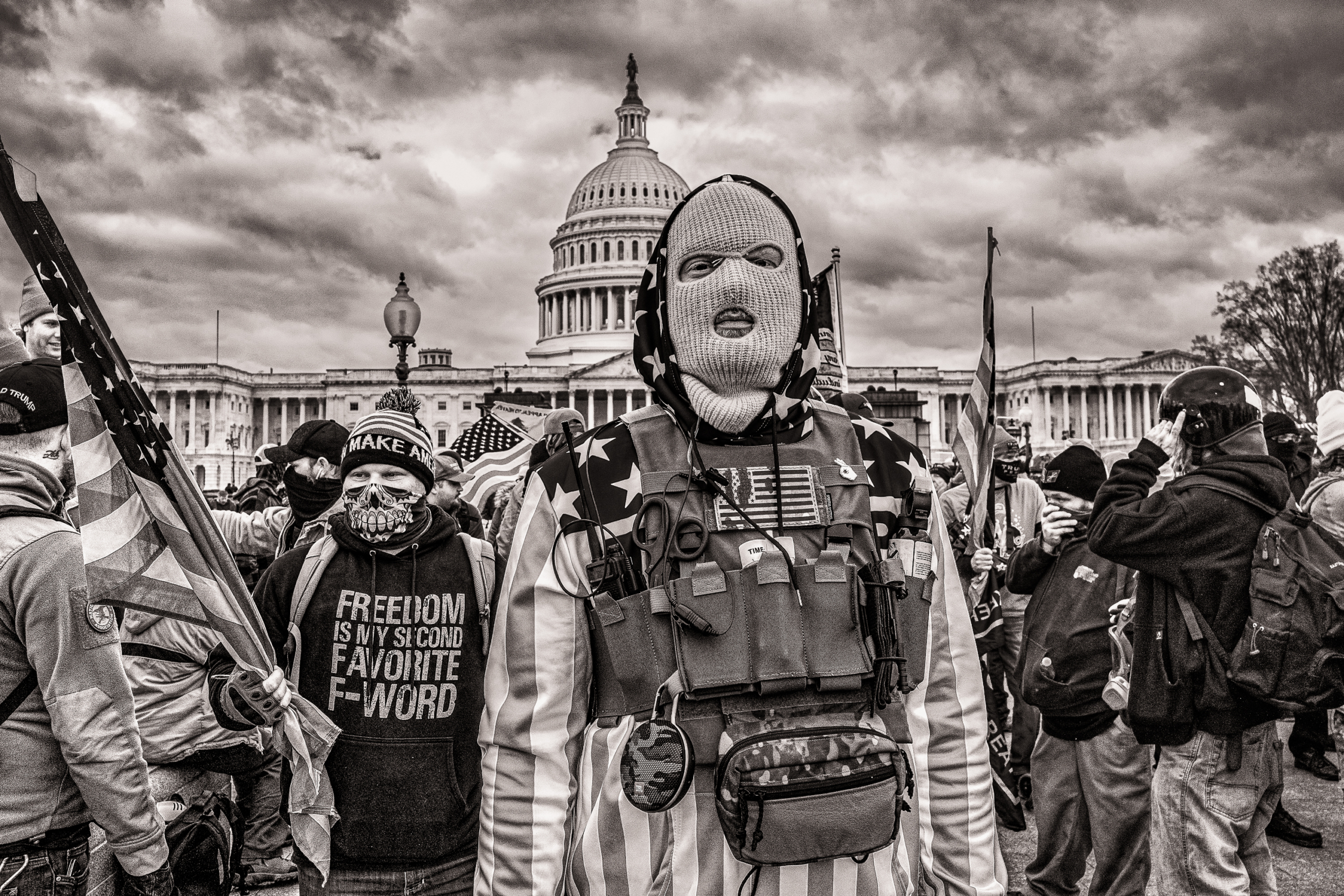
This is why I document: America loves to rebrand its sins as myth. In four years, MAGA loyalists have rewritten January 6 from every angle. Rioters have been framed as leftists in disguise, police as “crisis actors,” the attack an FBI setup—or, more outrageously, citizens on a “normal tourist visit.” By 2025, revisionism is big business. Conservative media churns out books, podcasts, and stump speeches recasting insurrection as resurrection. But my images tell another story: they depict a nation in fracture, where well-meaning neighbors and dutiful relatives cling to their “Big Lie” with an unwavering sincerity that doesn’t just reject facts—it inoculates against them, leaving everyone vulnerable to propaganda and less capable of critical thought.
The president’s blanket pardons for January 6 didn’t just free the charged and convicted. They effectively rewrote the past in real time, a direct assault on the historical record. I know what I saw. My photographs document a moment when democracy teetered, the nation’s timeline itself an active crime scene. As newsrooms contract and misinformation swells, independent journalists stand at the breach—not just to preserve truths that others reject, but to ensure the past isn’t rewritten to fit the present. The pardons don’t just forgive, they endorse, transforming accountability into proof of persecution. Without our work, this chapter, too, will be lacquered in sepia and sold as heritage.
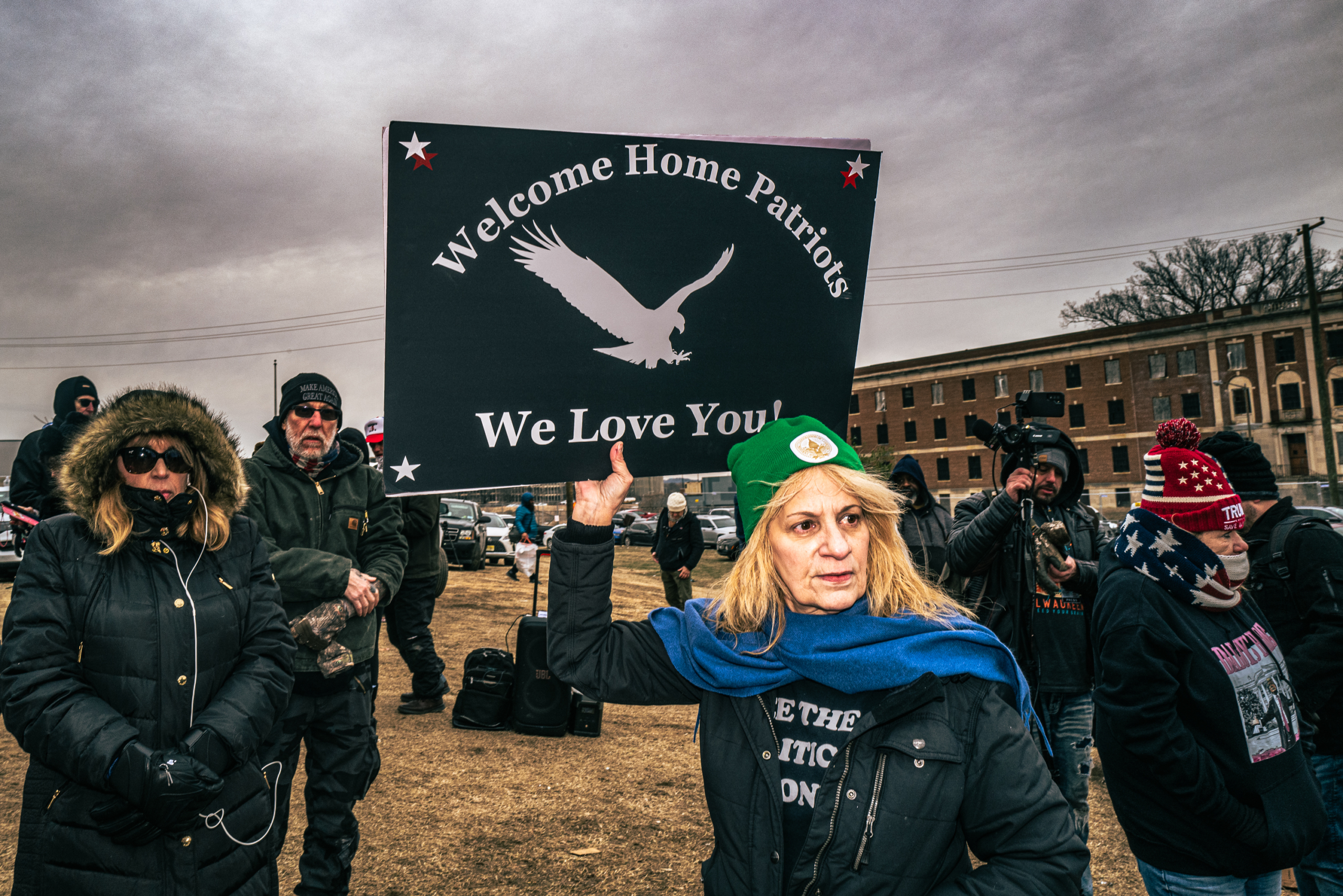
January 21, 2025. The celebration carries on. For more than nine hundred days, supporters have kept vigil outside this jail, waiting for the release of those they call “J6 Patriots.” Now they greet them as heroes. My partner, the photojournalist Carrie Schreck, and I duck into a neighborhood pub to thaw. She’s rattled—I see it in her shoulders, the way she grips her glass. We didn’t know each other on January 6, but she was there, too—navigating a crush of flesh and fury, praying that if she went down, her body would at least shield her camera’s memory card from being crushed. Unlike our press-corps peers in Kevlar and gas masks, we had only N95s—hers obscured by a red, white, and blue bandanna. Now, at the bar, she’s sharp but bleary-eyed, her frustration spilling over. A Proud Boy sidles up, trying to charm, trying to bait. Inexplicably, she doesn’t brush him off, but instead leans in, ready to spar. Soon, they’re locked in a lively debate.
Ronald Sandlin appears, beaming like an old friend as he grips my hand. His once-public record—assaulting officers, storming the Senate—is in the process of being deleted from the DOJ website. He offers to buy a round, laughing a little too hard as he recalls a hundred and thirteen days in solitary at the so-called “DC Gulag,” where suffocating heat met him at the door, a dead roach his only companion. Desperate, he prayed, but God didn’t answer—only a voice through a vent: “Shut up. You’re in hell, motherfucker.” Before long, he’s inviting us to a steakhouse dinner, a victory feast in honor of another freshly freed J6er named Jake Lang. The invitation isn’t just hospitality—it’s a show of power.
Cold, expensive light settles over a table of familiar faces. Sandlin grins, gesturing toward us: “The enemy—but they’re all right, they’re cool.” Wary chuckles. Seats scrape back, nods follow. Lang holds court like a returning war hero. For swinging a baseball bat at police during the Capitol attack, he spent four years in pretrial detention—nine hundred days of it in solitary—and emerged with a cult following. Now he’s flanked by his fiancée and a father whose relief outweighs reckoning. Peter Stager—dubbed “Caveman” by Sedition Hunters—sits nearby, no longer just the man once filmed beating an officer with an American-flag pole and declaring, “Death is the only remedy.” Tonight, he’s dapper and composed.
The table radiates warmth and magnanimity, the mayhem of that day replaced with easy laughter. Tomahawk steaks, lamb chops, filet mignon—a lavish spread. Lang thanks God for “people standing united against such an oppressive force.” Heads nod. Sandlin, who once roared at officers to get out of the way or die, now raises a glass, grinning. I’ve heard this before. On January 6, rioters boasted “This is the best day of my life!” and “One for the history books!” Now they’ve ensured it. Sitting here, it sinks in: they’ve won.

Near the end of the night, my phone buzzes—a text from my sister: my niece has just been born, exactly five years to the day since we unexpectedly lost our mother. The timing cracks my chest open. I slip away before the weight of it overtakes me. In the restroom, I grip the sink, steadying my breath. The door swings open. Footsteps. I wipe my eyes and stand straighter. Jake Lang’s father walks in, maybe assuming I’m licking my wounds—mourning some failure to lock in my version of January 6 before the revisionists bury it. He nods, clasping my shoulder like I’ve just run a hell of a race. Then, without missing a beat, he shares a Mother Teresa quote: “Do not allow yourselves to be disheartened by any failure as long as you have done your best. I know God will not give me anything I can’t handle. I just wish He didn’t trust me so much.” I exhale, torn between laughing, crying harder, or accepting these words for what they are—an offering, unexpected and oddly fitting, on this surreal American night.
This piece was produced with contributions from Carrie Schreck, a Los Angeles photographer, filmmaker, and essayist, and Lisa van Dam–Bates, a filmmaker and editor based in the Pacific Northwest.
Has America ever needed a media defender more than now? Help us by joining CJR today.



